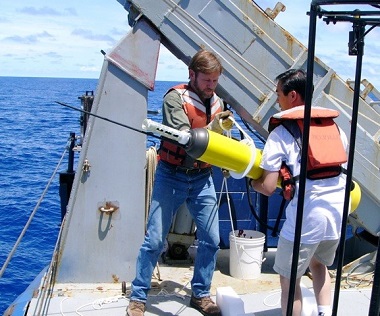370215-argo.jpg

An Argo float being deployed in 2004 between Hawaii and San Diego. Credit: Dr. James Swift, Scripps Institution of Oceanography, UC San Diego
In Greek mythology, the Argo was a ship that carried Jason and his band of heroes on adventures through unknown waters. Today, another Argo is exploring unknown waters. In fact, it’s turning the un-known into the known.
This Argo is an international project that’s measuring ocean conditions down to depths of almost a mile. It consists of more than 3800 probes that measure temperature, salinity, and currents in all the world’s oceans.
The project was named Argo because it was designed to complement an ocean-watching satellite called Jason. It got under way when the first probe was deployed in 2000.
The probes are cylinders that are about three-and-a-half feet long. A probe descends to about two-thirds of a mile and rides along with the currents for nine days. It then drops to about twice that depth, and begins a slow rise to the surface. As it ascends, it takes many readings of conditions along the way.
On the surface, the probe makes radio contact with a satellite. The satellite notes the probe’s position, which tells researchers how far the currents have carried it. The probe transmits its data to a control center, then drops back into the depths to begin a new cycle.
The readings allow scientists to track changes in the upper layers of ocean waters over time frames of months to years. That information shows researchers how the oceans change with the seasons. It also reveals changes over longer periods caused by our changing climate -- helping to erase some of the unknowns about the oceans.

